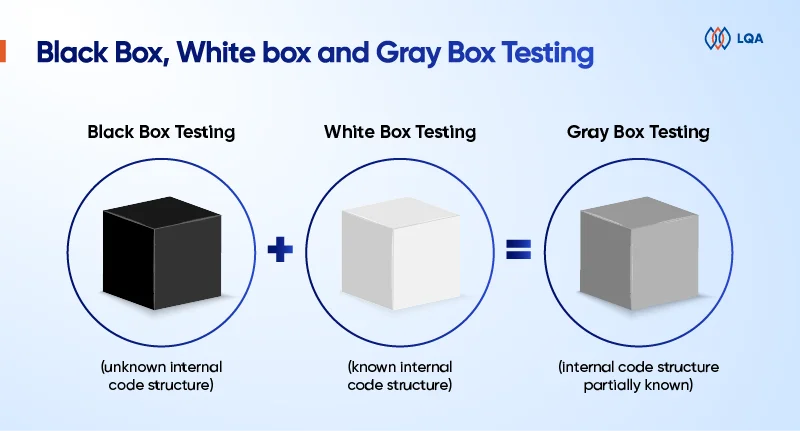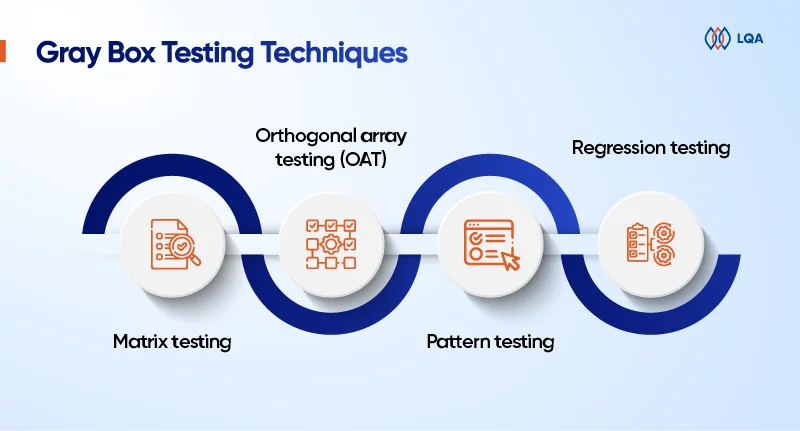Gray box testing, also spelled grey box testing, is a common method in software testing. The purpose of gray box testing is to search for defects due to improper structure or improper usage of applications.
In this blog, LQA will give you a comprehensive guide to gray box testing and the differences between black box, gray box, and white box testing.
What is Gray Box Testing?
Gray box testing is a software testing method in which testers have partial knowledge of the internal workings of an application.
The major objective of gray box testing is to combine the advantages of black box testing and white box testing to test the product from a user perspective and improve overall user acceptance of the product.
When doing gray box testing, the testing process is guided by the specifications or requirements set for the software. Testers create test cases based on what the software is supposed to do, hence they are called requirement test cases.
Example of gray box testing: Consider testing a mobile banking app. As a gray box tester, you may have some knowledge about the backend server communication. You design test cases to simulate various network conditions, like low connectivity, to observe how the app handles these situations.
Black-box vs. Gray-box vs. White-box Testing
We all know about the three common software testing methods: black box testing, gray box testing, and white box testing.

In black-box testing, testers have no idea about the system’s internal workings, while in white-box testing, testers have full knowledge of the application’s internal workings. Gray box testing is like a mix of black box and white box testing.
Let’s dive into a detailed comparison between black box, white box and gray box testing.
| Black box testing | Gray box testing | White box testing |
| Minimal to no knowledge of internal details | Partial knowledge of internal details | Full knowledge of internal details |
| Low-level granularity | Medium-level granularity | High-level granularity |
| Evaluates a product from the user’s perspective | Considers both the user’s perspective and developer’s perspective | Evaluation happens from the developer’s perspective |
| Is often done by end-users, testers and also developers | Can be done by developers, testers, and end-users | Is generally done by developers and testers |
| Test cases are designed on the functional specifications | Test cases are created based on both functional specifications and some internal knowledge | Test cases are designed based on the internal code and structure |
| Tend to consume the least time among the 3 methods | Tend to consume medium time among the 3 methods | Tend to consume the most time among the 3 methods |
Also read: Software testing basics, principles, skills, phase
Advantages and Disadvantages Of Gray Box Testing
So, what are the advantages and limitations of gray box testing?
Advantages of gray box testing
In short, gray box testing in software engineering combines the benefits of black box testing and white box testing.
- Testing accounts for user perspective to improve overall user acceptance of the product.
- Testers do not need to have programming expertise or extensive internal knowledge of the target system to start.
- Less chance of introducing bias compared to white-box testing, as testers don’t know the internal details fully.
- More comprehensive test scenario design than black-box testing thanks to partial knowledge of the internal mechanisms.
- Is non-intrusive because it doesn’t require full access to the internal code.
Disadvantages of gray box testing
Due to its partial access to the internal code of the system, gray box testing imposes certain limitations.
- Less test comprehensiveness compared to white-box testing. Due to limited access to complete code path coverage, testers might overlook critical vulnerabilities in the system.
- Difficult to associate defects with root causes in distributed systems. Distributed systems involve various components and interactions, but testers don’t have full visibility into them.
- Algorithm testing is impossible as the lack of access to the complete logic of the algorithms.
Gray Box Testing Techniques
When performing gray box testing, there are various techniques you can choose from.
Matrix testing
Matrix testing is a testing approach that examines all variables in an application, evaluating all business and technical risks associated with them and ensuring their correct and efficient utilization.
In matrix testing, test cases are systematically designed and executed based on a testing matrix structure. The matrix typically represents different combinations of inputs, conditions, or variables that need to be tested.
Orthogonal array testing (OAT)
Orthogonal array testing, or OAT, is basically a systematic and statistically-driven black-box testing technique. It systematically selects specific combinations of inputs to test the system instead of testing every possible combination of inputs.
Imagine you are dealing with a large number of inputs. Now, testing every possible combination of inputs would take a long time. So, you pick a subset of combinations to test from an orthogonal array, which is a structured grid ensuring coverage of various combinations of factor levels.
This method helps achieve a balance between thorough testing and minimizing the number of test cases required.
Pattern testing
Pattern testing in gray box testing involves analyzing historical defects to recognize recurring patterns associated with defects. Then, you can apply those insights to detect anomalies or deviations in coding practices that may lead to errors or vulnerabilities in apps with similar structures.
Example of pattern testing: Checking for consistent coding practices in naming conventions throughout the application.
Regression testing
Regression testing is a technique that verifies whether new changes affect the existing functioning of the system. Common regression test strategies are retest all, retest risky use cases, and regression test selection.
Regression testing is often done when there are modifications to a system, such as developing a new function or fixing a bug. In apps with frequent updates, regression testing is often automated for optimal efficiency.
The Gray Box Testing Process
A standard gray-box testing process comprises 10 steps as below:
#Step 1: Identify and select inputs
Choose inputs for testing from both white and black box testing methods, considering both external user interactions (black box) and partial knowledge of internal workings (white box).
#Step 2: Identify probable outputs
Determine expected outcomes corresponding to the selected inputs to establish criteria for successful testing.
#Step 3: Identify key paths for the testing phase
Recognize critical paths within the system that need to be tested to ensure comprehensive coverage.
#Step 4: Identify sub-functions
Break down the system into sub-functions for more focused and in-depth testing.
#Step 5: Identify inputs for subfunctions
Determine inputs specific to each sub-function, tailoring tests to assess individual components.
#Step 6: Identify probable outputs for subfunctions
Anticipate expected outputs corresponding to inputs for each identified sub-function.
#Step 7: Execute sub-function test cases
Perform tests on isolated sub-functions to observe how they respond to various inputs.
#Step 8: Assess and verify outcomes.
Evaluate test results to verify whether the system behaves as expected and meets specified criteria.
#Step 9: Repeat steps 4 & 8 for other subfunctions
#Step 10: Repeat steps 7 & 8 for other subfunctions
Frequently Asked Questions about Gray Box Testing
1. What is gray box penetration testing?
Gray box penetration testing is a cybersecurity assessment approach where the tester is provided with some information, such as system architecture or design details, to simulate the perspective of an attacker with limited insider knowledge.
Gray box penetration testing alongside black box penetration testing and white box penetration testing make up the 3 common penetration testing methods in security testing.
2. What is the difference between gray-box and black-box testing?
The fundamental difference between gray box testing and black box testing is how much testers know about the internal workings of a system, which can be a web app, a mobile app, or a desktop app.
Gray box testers have partial knowledge of the internal details of the system, hence testing the system from both a user perspective and developer perspective.
Black box testers have no idea about the internal details of the system, hence testing the system from a user perspective completely.
3. What is gray box testing also known as?
According to the National Institute of Standards and Technology (NIST), gray box testing is also known as focused testing.
Gray Box Testing by LQA
Gray-box testing is beneficial because it merges the benefits of black box testing and white box testing, combining the simplicity of the black-box approach with the code-specific approach of the white-box approach.
As the pioneering independent software testing company in Vietnam, LQA stands out as a prominent software quality assurance firm with a wide range of software testing services, covering gray box, white box, and black box testing.
Are you looking for experts in conducting gray box testing services? Don’t hesitate to contact LQA’s software testing team.
Contact LQA at:
- Email: [email protected]
- Website: https://lotus-qa.com/
- LinkedIn: https://www.linkedin.com/company/lqa



